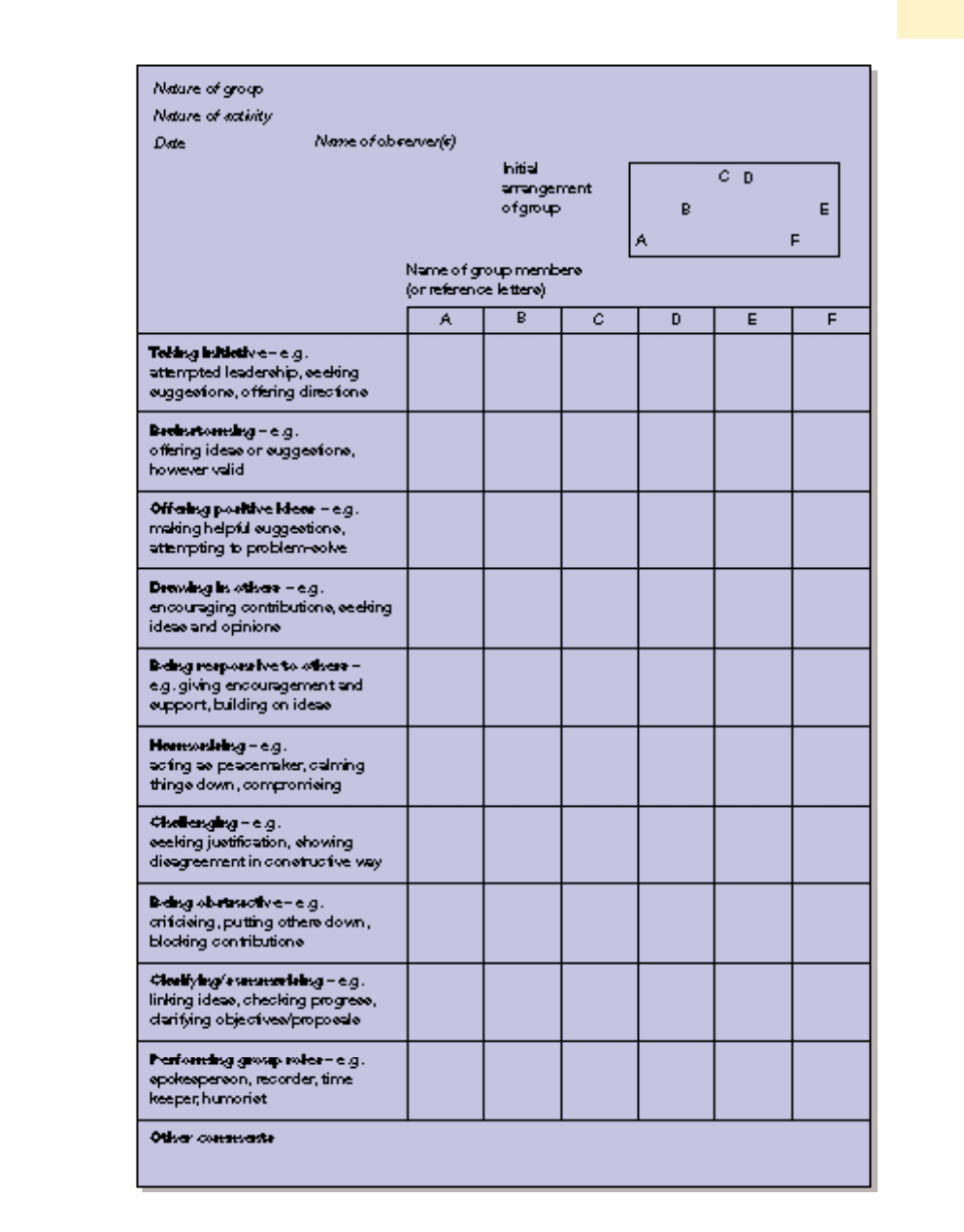Mullins L.J. Management and organisational behaviour, Seventh edition
Подождите немного. Документ загружается.


■ Group task roles. These assume that the task of the group is to select, define and
solve common problems. Any of the roles may be performed by the various mem-
bers or the group leader.
■ Group building and maintenance roles. The analysis of member functions is
oriented towards activities which build group-centred attitudes, or maintain group-
centred behaviour. Contributions may involve a number of roles, and members or
the leader may perform each of these roles.
■ Individual roles. These are directed towards the satisfaction of personal needs. Their
purpose is not related either to group task or to the group functioning.
Several frameworks have been designed for observers to categorise patterns of verbal
and non-verbal behaviour of group or team members. Observers chart members’
behaviour on specially designed forms. These forms may be used to focus on single
individuals, or used to record the total interaction with no indication of individual
behaviour. The system of categorisation may distinguish between different behaviours
in terms of the functions they are performing. The completed observation forms can
be used as a basis for discussion of individual or group performance in terms of the
strengths/weaknesses of different functional behaviour. In the framework shown in
Figure 14.5 there are two observation sheets, one covering six types of leader–member
task-function behaviour and the other covering six types of leader–member group
building and maintenance function behaviour.
Use of different frameworks
Different frameworks use a different number of categories for studying behaviour in
groups. The interaction analysis method can become complex, especially if non-verbal
behaviour is included. Many of the categories in different frameworks may at first sight
appear to be very similar. It is important, therefore, to keep the framework simple, and
easy to understand and complete. The observer’s own personality, values and attitudes
can influence the categorisation of behaviour. For these reasons it is preferable to use
trained observers, and wherever possible and appropriate to use more than one
observer for each group. The observers can then compare the level of consistency
between their categorisations. Observation sheets can be designed to suit the particular
requirements of the group situation and the nature of the activity involved. An ex-
ample of a reasonably simple, ten-point observation sheet used by the author is given
in Figure 14.6.
Where appropriate, it may be helpful to note the initial seating, or standing, arrange-
ments of the group. This will help in the identification of group members. Depending
on the nature of the activity involved, it might also be possible to indicate main chan-
nels of interaction among individuals – for example, to whom eye contact, hand
movements, or ideas and questions are most frequently directed. A note could also be
made of changes in arrangements during, and at the end of, the activity. Headings on
the observation sheet are not necessarily exclusive. For example, leadership could be
included under Taking Initiative, or under Performing Group Roles. Similarly, the role
of humorist could be included under Performing Group Roles, but might also appropri-
ately be included under the heading of Harmonising.
Observers will tend to use their own methods for completing the sheet: for example,
a simple stroke or tick for each contribution and perhaps a thick stroke for a particu-
larly significant contribution. Some observers might use some other distinguishing
CHAPTER 14 WORKING IN GROUPS AND TEAMS
565
FRAMEWORKS OF BEHAVIOURAL ANALYSIS
Completing the
observation
sheet

mark to indicate non-verbal behaviour such as body movements, smiles or eye contact.
The most important point, however, is that the charting should not become too com-
plex. The observer should feel happy with the framework and be capable of explaining
the entries in a meaningful way. Where more than one observer is present there should
be some degree of consistency between them.
Groups and teams are an essential feature in the life of the work organisation. For
example, as Coghlan points out:
Membership of teams and groups shape an individual’s perception and participation in organ-
izational change ... Groups and teams play a keyrole in the process of planned organizational
change. The change process typically involves teams in the organization’s hierarchy responding
to the change agenda and adapting to it in terms of its tasks and processes.
24
566
PART 5 GROUPS AND TEAMWORK
GROUP BUILDING AND MAINTENANCE FUNCTIONS
1 Encouraging: being friendly, warm and responsive to others, accepting others and their contri-
butions, regarding others by giving them an opportunity for recognition.
2 Expressing group feelings: sensing feeling, mood, relationships within the group, sharing one’s
own feelings with other members.
3 Harmonising: attempting to reconcile disagreements, reducing tension through ‘pouring oil on
troubled waters’, getting people to explore their differences.
4 Compromising: when own idea or status is involved in a conflict, offering to compromise own
position, admitting error, disciplining oneself to maintain group cohesion.
5 Gatekeeping: attempting to keep communication channels open, facilitating the participation of
others; suggesting procedure for sharing opportunity to discuss group problems.
6 Setting standards: expressing standards for group to achieve, applying standards in evaluating
group functioning and production.
Figure 14.5 Observation sheets for behavioural analysis
(Source: National Training Laboratory, Washington DC (1952).)
TASK FUNCTIONS
1 Initiating: proposing tasks or goals; defining a group problem, suggesting a procedure or ideas
for solving a problem.
2 Information or opinion seeking: requesting facts, seeking relevant information about a group
concern, asking for suggestions and ideas.
3 Information or opinion giving: offering facts, providing relevant information about group con-
cern; stating a belief; giving suggestions or ideas.
4 Clarifying or elaborating: interpreting or reflecting ideas and suggestions; clearing up confu-
sions; indicating alternatives and issues before the group, giving examples.
5 Summarising: pulling together related ideas, restating suggestions after group has discussed
them; offering a decision or conclusion for the group to accept or reject.
6 Consensus testing: sending up ‘trial balloons’ to see if group is nearing a conclusion; checking
with group to see how much agreement has been reached.
AN ESSENTIAL FEATURE OF WORK ORGANISATIONS

CHAPTER 14 WORKING IN GROUPS AND TEAMS
567
Figure 14.6 Observation sheet for behaviour in groups

Individuals on teams interact extensively with one another, and with other teams in the
organisation. Team-based management is used to improve communication, co-ordina-
tion and co-operation within the organisation.
25
For example, as Green maintains:
The generally perceived advantages of working in teams are the release of creativity and energy,
much more interaction between people satisfying the need to belong … Team working can improve
efficiency by people planning activities together with cooperation and communication. Team mem-
bers together should be able to identify many ways to improve work organisation; how information,
ideas and outputs flow and how team-working can reduce costs and improve productivity.
26
Balance between the team and the individual
We mentioned previously the need to balance effective team performance with respect
for the individual members. For example, as James points out: ‘Effective teams need
equilibrium, no matter how uneasy. The perfect team will have balance, with each
member aware of their role and happy to add that value to the task. The natural lead-
ers for any given job will be in charge and their leadership will be cherished by mutual
consent. Being a perfect team member means commitment to the task overrides per-
sonal ambition and glory. Unfortunately this is rarely achieved in the workplace.’
27
Successful organizations are good at building teams and exploiting teamwork. People need to be
able to work in teams; they need to subordinate their own agenda to the wellbeing of the group.
Further, organizations need to foster diversity, which entails respect for the individual and makes
group decision making more creative.
28
Skills for successful teamwork
The increasing need for collaboration and teamwork together with recognition for the
individual has highlighted the need for attention to social skills and effectively rela-
tionships among people. If people are not working together they are essentially a
collection of individuals. For example, Douglas refers to the importance of helping
people to master the so-called ‘soft’ skills.
Organisations in most sectors – and especially in ones that are particularly demanding from a
scientific or technical point of view – are operating in environments where collaboration, team-
work, and an awareness of the commercial consequences and implications of technical research
are as important as scientific and technical skills themselves. Personnel with scientific and tech-
nical skills significantly disproportionate to their ‘people’ skills – by which I primarily mean
people management capabilities and the knowledge of how to work with maximum effectiveness
as part of a team – are increasingly unlikely to be as much of an asset to their organisation as
they ought to be.
29
However, Douglas points out that as
we all interact with people to a
greater or lesser extent in our every-
day lives there is a tendency to
assume that people management
skills are merely an extension of our
natural abilities. In fact people man-
agement skills are the more difficult
and rare type of skill but to a large
extent they can be learned.
Building successful teams also
requires effective leadership with
an emphasis on trust, clear commu-
nications, full participation and
self-management. ‘The influence
568
PART 5 GROUPS AND TEAMWORK
An example of teamwork in action
Photo: Peter Spurrier/Action Plus

and
usefulness of team leaders comes, not from their delivery of traditional supervisory
and control methods, but from their ability to lead from the front and in training, coach-
ing and counselling their team members to high standards of performance.’
30
It is, however, difficult to draw any firm conclusions from a comparison between indi-
vidual and group or team performance. An example of this can be seen from a
consideration of decision-making. Certain groups, such as committees, may be con-
cerned more specifically with decision-making, but all groups must make some
decisions. Group decision-making can be costly and time-consuming.
One particular feature of group versus individual performance is the concept of
social loafing and the ‘Ringelmann effect’, which is the tendency for individuals to
expend less effort when working as a member of a group than as an individual. A
German psychologist, Ringelmann, compared the results of individual and group per-
formance on a rope-pulling task. Workers were asked to pull as hard as they could on a
rope, performing the task first individually, and then with others in groups of varying
size. A meter measured the strength of each pull. Although the total amount of force
did increase with the size of the work group, the effort expended by each individual
member decreased with the result that the total group effort was less than the expected
sum of the individual contributions.
31
Replications of the Ringelmann effect have gen-
erally been supportive of the original findings.
32
According to Hall, there is a danger of elevating teams into a ‘silver bullet’ – a magic
solution to all business problems. ‘It is not that I don’t think teams work. They clearly
do and it would be difficult to run an organisation of any size if you couldn’t create and
manage a team … The truth is that teams are not always the right answer to a problem.
Often a well-briefed and well-managed group of individuals will do a task fine … A fur-
ther point is that some very skilled individuals are not good team players.’
33
However, the general feeling appears to be that the collective power of a group out-
shines individual performance.
34
‘Even though individuals working on their own are
capable of phenomenal ingenuity, working together as a team can produce astounding
results and a better decision.’
35
Guirdham believes that: ‘Compared with individuals, groups
can make objectively better decisions to which people feel more commitment, while teams
can perform functions and carry out projects better and more efficiently. This can only
happen, however, if the people have the special skills and abilities needed.’
36
One might expect, therefore, a higher standard of decision-making to result from
group discussion. However, on the one hand, there is the danger of compromise and
decisions being made in line with the ‘highest common view’; and, on the other hand,
there is the phenomenon of the so-called risky-shift.
This suggests that instead of the group taking fewer risks and making safer or more
conservative decisions, the reverse is often the case. Pressures for conformity means
there is a tendency for groups to make more risky decisions than would individual
members of the group on their own. Studies suggest that people working in groups
generally advocate more risky alternatives than if they were making an individual deci-
sion on the same problem.
37
Presumably, this is because members do not feel the same sense of responsibility for
group decisions or their outcomes. ‘A decision which is everyone’s is the responsibility
of no one.’ Other explanations offered for the risky-shift phenomenon include:
CHAPTER 14 WORKING IN GROUPS AND TEAMS
569
INDIVIDUAL COMPARED WITH GROUP OR TEAM PERFORMANCE
THE RISKY-SHIFT PHENOMENON

1 People inclined to take risks are more influential in group discussions than more
conservative people.
2Risk-taking is regarded as a desirable cultural characteristic which is more likely to be
expressed in a social situation such as group working.
38
However, groups do appear to work well in the evaluation of ideas and to be more effective
than individuals for problem-solving tasks requiring a range of knowledge and expertise.
From a review of the research Shaw suggests that evidence supports the view that groups
produce more solutions and better solutions to problems than do individuals.
39
The effectiveness of group behaviour and performance can be adversely affected by the
idea of ‘groupthink’. From an examination of some well-known government policy-
making groups, Janis concluded that decisions can be characterised by groupthink which
he defines as: ‘a deterioration of mental efficiency, reality testing, and moral judgment
that results from in-group pressures’.
40
Groupthink results in the propensity for the group
to just drift along. It is a generalised feature and can be apparent in any organisational
situation where groups are relied upon to make important decisions.
Janis identifies a number of specific symptoms of groupthink.
1There is an illusion of invulnerability with excessive optimism and risk-taking.
2 The discounting or discrediting of negative feedback which contradicts group con-
sensus results in rationalisation in order to explain away any disagreeable
information.
3 An unquestioned belief in the inherent morality of the group which leads mem-
bers to be convinced of the logical correctness of what it is doing and to ignore
ethical or moral consequences of decisions.
4 The group’s desire to maintain consensus can lead to negative stereotyping of
opponents or people outside the group, or to the acceptance of change.
5 There is pressure on individual members to conform and reach consensus so that
minority or unpopular ideas may be suppressed.
6 Each member of the group may impose self-censorship in order to suppress their
own objectives, or personal doubts or disagreements.
7 As a result of self-censorship, there is an illusion of unanimity with a lack of
expressed dissent and a false sense of unity.
8 In the unlikely event of dissent or contrary information, this will give rise to the
emergence of ‘mind guards’ who act as filters, guarding group leaders, deflecting
opposition and applying pressure on deviants.
According to Hambrick: ‘Groupthink tends to occur when group members have very
similar experiences and frame of references, particularly when they have relatively long
tenures in the group. A company head who dislikes conflict or who punishes dissenters
also creates the conditions for groupthink.’
41
A brainstorming approach involves the group adopting a ‘freewheeling’ attitude and
generating as many ideas as possible, the more wild or apparently far-fetched the
better.
42
As an illustrative exercise a group may be asked to generate as many and
varied possible uses as they can for, for example, a house brick or a car fan belt.
570
PART 5 GROUPS AND TEAMWORK
‘GROUPTHINK’
BRAINSTORMING

There are a number of basic procedures for brainstorming.
■ It is based on maximum freedom of expression with a totally informal approach.
■ The initial emphasis is on the quantity of ideas generated, not the quality of ideas.
■ No individual ideas are criticised or rejected at this stage, however wild or fanciful
they may appear.
■ Members are encouraged to elaborate or build on ideas expressed by others, and to
bounce suggestions off one another.
■ There is no comment on or evaluation of any particular idea until all ideas have
been generated.
Brainstorming is based on encouraging members to suspend judgement, the assump-
tion that creative thinking is achieved best by encouraging the natural inclinations of
group members, and the rapid production and free association of ideas. The quantity
of ideas will lead to quality of ideas.
An interesting and popular exercise to help illustrate the suspension of initial per-
ceived barriers and the encouragement of creative thinking is given in Figure 14.7. This
exercise may also be used to compare individual and group/team-based performance.
Your tutor will provide the (or least one) answer. There may be others that the
author is unaware of!
Effectiveness of brainstorming groups
One might reasonably expect that members of a brainstorming group would produce
more creative problem-solving ideas than if the same members worked alone as indi-
viduals. Availability of time is an important factor. Over a longer period of time the
group may produce more ideas through brainstorming than individuals could. Perhaps
surprisingly, however, there appears to be doubt about the effectiveness of brainstorm-
ing groups over an individual working under the same conditions. Research findings
suggest that brainstorming groups can inhibit creative thinking. The general tenor
appears to be that research studies have not substantiated claims that brainstorming
groups generate more and better ideas than the same number of individuals working
on their own.
43
Nevertheless, brainstorming still appears to have many advocates and
is a popular activity for staff development programmes.
44
(See Figure 14.8.) Despite the
rather negative view of nominal group brainstorming, we should recognise the impor-
tance of innovation for successful organisational performance.
45
Any procedure which
aids the process of creativity should be welcomed and there are a number of potential
positive achievements in terms of related structural techniques for stimulating innova-
tion. These include the Delphi technique and quality circles.
CHAPTER 14 WORKING IN GROUPS AND TEAMS
571
Figure 14.7 An example of creative thinking

The Delphi technique is based on multiple, anonymous inputs from individual mem-
bers of the group. Ideas and suggestions are recorded by a central manager and then
recirculated to other members for their feedback. The central manager collates the
responses and continues the circulation process again until consensus is reached.
Although a time-consuming process the Delphi technique helps to overcome the limi-
tations of face-to-face brainstorming and symptoms of groupthink.
Quality circles are discussed in Chapter 18.
572
PART 5 GROUPS AND TEAMWORK
Figure 14.8 Advantages of brainstorming
Source: Susan Bishop and David Taylor, Developing Your Staff, Pitman Publishing/Longman Training (1994). Reproduced with permission
from Pearson Education Ltd.)
BRAINSTORMING
Brainstorming is a problem-solving/solution-finding technique which can be used
by individuals, groups or teams. Its full benefit is gained by sharing ideas and
possibilities with others.
The first step is to define the problem or situation to which the group or team
wants solutions or ideas. Ideally one person should act as scribe, and write up
ideas on a flipchart. He or she can contribute, but should not comment on others’
suggestions. Every idea should be written up, however far-fetched or silly it might
seem, without challenge from others.
Everyone should be encouraged to participate.
When all possibilities have been exhausted, suggestions can be examined, clari-
fied, amended, accepted or rejected.
It may be that several options are accepted as possible ways forward. Reverse
brainstorming looks at the possibilities and then brainstorms all the problems
associated with the ideas. This helps give an objective view of ideas or solutions.
If performed correctly, brainstorming is an excellent, non-threatening way to
include all members of a team in the problem-solving/decision-making process. It
has the added benefit of producing many and various ideas, some of which will
be of no value, but others which may be of immediate or future benefit. Creativity
is contagious, and one idea will spark off another. Often, it is one of the most
apparently silly ideas that points the way to a solution.
Brainstorming:
● involves everyone;
● focuses the mind;
● encourages creativity;
● meets individual needs for team inclusion;
● encourages communication – listening, information sharing;
● maximises ideas/possible solutions to problems;
● minimises risk of overlooking elements of the problem or issue under question.

Interest in the study of group process and behaviour has led to the development of
group dynamics and a range of group training methods aimed at increasing group effec-
tiveness through improving social interaction skills.
Group dynamics is the study of interactions and forces within small face-to-face
groups. It is concerned with what happens when groups of people meet.
A central feature of group dynamics is sensitivity training, in which members of a
group direct attention to the understanding of their own behaviour and to perceiving
themselves as others see them. The objectives are usually stated as:
■ to increase sensitivity (the ability to perceive accurately how others react to oneself);
■ diagnostic ability (the skill of assessing behavioural relationships between others
and reasons for such behaviour); and
■ behavioural flexibility, or action skill (the ability to relate one’s behaviour to the
requirements of the situation).
An account of ‘problems’ that have arisen with team-building exercises is given in
Management in Action 14.2.
CHAPTER 14 WORKING IN GROUPS AND TEAMS
573
Management: brainstorm in a rainstorm
Use the theatre to fire creativity writes Arkady Ostrovsky
J
ackets come off, ties are loosened; 20 senior busi-
ness people howl, whisper and run around throwing
their arms about.
Their bizarre behaviour is part of an exercise to use the-
atre to fuel their imagination and creativity.
One participant, Richard Hardman, international explo-
ration director at US oil group Amerada Hess, says: ‘If you
want to get fit physically you go to the gym, but what do
you do if your imagination needs some stretching? Theatre
is very good for it.’
Four weeks of visits to theatrical events and a day’s
seminar and workshop took place recently during the
annual London International Festival of Theatre. Events
were held in association with the Global Business Network,
a business strategy group, and the FT.
At one, executives took a barefoot, sensual journey
through a dark labyrinth inhabited by personifications of des-
tiny and death. At another, they were deafened by music and
sprinkled with water and tickertape as they stood in a dark-
ened warehouse watching Argentinian troupe De La
Guarda’s crazed, swooping musician-acrobats.
Richard Wise, chief financial officer at Coutts, the bank,
says: ‘You are so bound up with day-to-day imperatives that
you lose the creative aspect. We tend to deal in very ration-
alised business structures – these performances show the
benefit of brainstorming unconventional solutions.’
Performers and business people had a chance to meet
after events – to the benefit of both sides, says Julia
Rowntree, of the festival. ‘It encourages the artist to learn
more about the motives that drive the business world and, in
some way, to have their say in it. For business people, it is a
chance to discover what is going on outside their offices and
to look at their own business from an outside perspective.’
The benefits of such exercises are notoriously difficult to
measure. But, says Rick Haythornthwaite, director of
Premier Oil, and a participant: ‘If you test the success of
this venture through the quality of thinking and the open-
mindedness of the people who participate in it, back in the
work place over the coming months and years, it is
undoubtedly working.’
(Reproduced with permission from the Financial Times Limited, © Financial
Times.)
EXHIBIT 14.1
FT
GROUP DYNAMICS

A usual method of sensitivity training (which is increasingly used as a generic term) is
the T-group (training group), sometimes called laboratory training.
A T-group has been defined as:
an approach to human relations training which, broadly speaking, provides participants with an
opportunity to learn more about themselves and their impact on others, and in particular to learn
how to function more effectively in face-to-face situations.
46
The original form of a T-group is a small, leaderless, unstructured, face-to-face group-
ing. The group normally numbers between 8 and 12 members who may be strangers to
each other or who may come from the same organisation (a family group). A deliberate
attempt is made to minimise any status differentials among members. There is no
agenda or planned activities. Trainers are present to help guide the group, but do not
usually take an active role or act as formal leader. The agenda becomes the group’s own
behaviour in attempting to cope with the lack of structure or planned activities.
Training is intended to concentrate on process rather than content, that is on the feel-
ing level of communication rather than the informational value of communication.
Faced with confusion and lack of direction, individuals will act in characteristic ways.
With the guidance of the trainers these patterns of behaviour become the focus of atten-
tion for the group. Participants are encouraged to examine their own self-concepts and
to be more receptive to the feelings and behaviours of others. Feedback received by indi-
viduals from other members of the group is the main mechanism for learning. This
feedback creates a feeling of anxiety and tension, and the individual’s own self-examina-
tion leads to consideration of new values, attitudes and behaviour. Typically, the group
meets for a 1
1
–
2
- to-2-hour session each day for up to a fortnight. The sessions are sup-
ported by related lectures, study groups, case studies and other exercises.
A simple framework for looking at self-insight, which is used frequently to help indi-
viduals in the T-group process, is the ‘Johari window’ (see Figure 14.9). This classifies
behaviour in matrix form between what is known–unknown to self and what is
known–unknown to others.
47
A central feature of the T-group is reduction of the indi-
vidual’s ‘hidden’ behaviour through self-disclosure and reduction of the ‘blind’
behaviour through feedback from others.
■ Hidden behaviour is that which the individual wishes to conceal from, or not to
communicate to, other group members. It is part of the private self. An important
574
PART 5 GROUPS AND TEAMWORK
T-GROUPS
The Johari
window
Behaviour
known to self
Behaviour
unknown to self
Behaviour known
to others
Behaviour unknown
to others
PUBLIC BLIND
HIDDEN UNKNOWN
Figure 14.9 The Johari window
